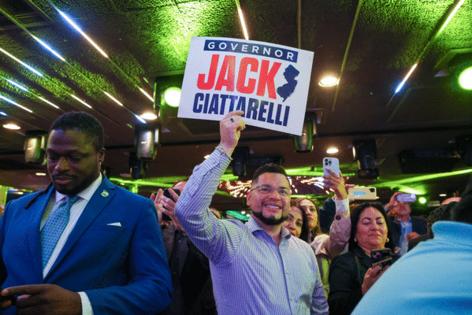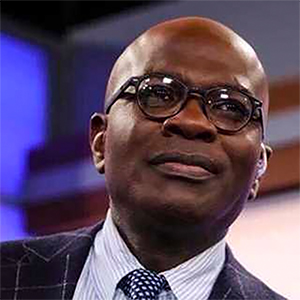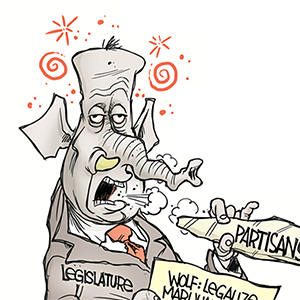Ronald Brownstein: The NJ and Virginia governors' races will answer a key question
Published in Op Eds
The gubernatorial races next week in Virginia and New Jersey will offer the best measure yet of whether the Democratic Party has begun to reverse its losses among two key groups: prosperous suburbanites and economically strained racial minorities. Both groups shifted enough toward President Donald Trump and the GOP last year to help propel Republicans to total control of the federal government.
Democratic gubernatorial nominees Abigail Spanberger in Virginia and Mikie Sherrill in New Jersey appear on track to counter Trump’s inroads in upscale suburbs. That alone makes both women — especially Spanberger — the favorites in states that house large numbers of college graduates (and also usually elect governors from the party that’s out of the White House).
Less clear is whether either woman can dislodge the beachheads Trump established for Republicans with working-class minorities. That may be a more important long-term question for the party — and the most revealing sign sent by the 2025 results.
Of the two discouraging trends for Democrats in 2024, the erosion among suburban professionals was the most surprising. Between 2016 and 2024, the movement of college-educated voters of all races away from the GOP had been among the most powerful trends in US politics.
But Vice President Kamala Harris fell short of President Joe Biden’s 2020 margins in well-educated suburbs nationwide, including in New Jersey and Virginia. (Harris, for instance, barely squeezed past 50% in highly educated Bergen County, the weakest 21st-century showing there for a Democratic presidential nominee.) Mike DuHaime, a veteran New Jersey Republican strategist, says that erosion reflected the pervasive view that Democrats had mismanaged the economy under Biden. Suburban voters “are tolerant on the social issues but they don’t think they should distract you from the economy,” he told me.
Now, though, Trump is the focal point for continuing frustration over high prices. Even more important, college-educated voters consistently express the most alarm in polls about his moves to centralize presidential authority and shred constitutional safeguards.
Winsome Earle-Sears and Jack Ciattarelli, the Republican gubernatorial nominees in Virginia and New Jersey, have responded by highlighting cultural wedge issues that have historically benefited Republicans, particularly concerns relating to transgender students. But both have bound themselves so tightly to Trump — “I think he’s right about everything that he’s doing,” Ciattarelli declared in a recent debate — that they are unlikely to escape that undertow. (Earle-Sears faces further challenges with college-educated voters, both because she’s an ardent social conservative and because Northern Virginia has been hit so hard by the Elon Musk-led DOGE cutbacks in federal employment and contracting.) Polls show a majority of all voters in both states disapprove of Trump’s job performance, and nearly nine-in-ten of those disapprovers are backing the Democratic candidates.
Against that backdrop, neither Republican may match Trump’s 2024 performance in the upscale suburbs of their respective states, which now include large populations of financially comfortable college graduates, both White and non-White, especially in Virginia. They may not even match the GOP’s showing in those places in the 2021 gubernatorial races, when Republican Glenn Youngkin won in Virginia and Ciattarelli fell narrowly to Democratic Governor Phil Murphy. “Those [suburban] doors are not closed, it’s just that generally you have to run a perfect game to win [them] in Virginia and some of the factors you don’t control,” said Virginia Republican strategist Zack Roday, in comments echoed by DuHaime about New Jersey.
Much less certain is whether Spanberger and Sherrill can recover with the blue-collar Black, Hispanic and Asian-American voters who represented Trump’s most important addition to the GOP coalition nationwide in 2024. Those gains were especially head-turning in New Jersey: Geoffrey Skelley of the Decision Desk HQ website recently calculated that Trump’s biggest New Jersey gains came in areas with the largest non-White populations. In the heavily Hispanic communities of Passaic, Paterson, Elizabeth and Perth Amboy, Trump ran about 30 percentage points better in 2024 than in 2020. In heavily Black communities such as Newark, Trenton and Camden, he improved by double digits.
Spanberger and Sherrill have each centered their campaigns on “affordability” issues headlined by utility bills and health-care costs, which reflect the emerging Democratic party consensus about the best way to reconnect with working class voters of all races. Yet they are cautious centrists, not populists. Each has represented an affluent suburban House district. Each remains an imperfect fit for the urban, working-class voters of color who have strayed toward Trump.
Lauren Victoria Burke, publisher of Black Virginia News, told me that although the Black community “is not crazy with excitement” about Spanberger, she believes the Democrat will get the margins she needs because “if you are trying to send a message to Donald Trump, this is your moment.” Likewise, Nedia Morsy, director of Make the Road Action New Jersey, a group that organizes Hispanics, predicts that “while there is some disillusionment” with Democrats, discontent over prices and anger over Trump’s aggressive immigration enforcement will move enough of those voters to back Sherrill. On both fronts, she says, Hispanics “are living the untruths” of what Trump promised in 2024.
But Tory Gavito, president of Way to Win, a group that works to elect progressive candidates of color, cautions that it may be difficult for Spanberger and Sherrill to regain non-White working-class voters. Those voters are “a tougher bind for Democrats,” Gavito told me. “Because we don’t have to convince them that life is tough; you have to convince them that Democrats are going to do something about it.”
Improving among working-class voters of color in 2025 wouldn’t guarantee a Democratic recovery with them in 2026 or 2028, since Trump made his biggest gains last year among low-propensity voters who are the least likely to turn out for an odd-year governor’s race. But if Spanberger and Sherrill fail to improve with minority blue-collar voters after so heavily stressing affordability, that would be a troubling sign for their party, no matter the overall outcome. Spanberger heads into the final days with a more secure advantage than Sherrill, but even if both women triumph, how they get over the top will be nearly as revealing as whether they do.
____
This column reflects the personal views of the author and does not necessarily reflect the opinion of the editorial board or Bloomberg LP and its owners.
Ronald Brownstein is a Bloomberg Opinion columnist covering politics and policy. He is a CNN analyst and the author or editor of seven books.
©2025 Bloomberg L.P. Visit bloomberg.com/opinion. Distributed by Tribune Content Agency, LLC.
























































Comments